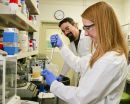(Press-News.org) Findings from Nationwide Children's Hospital physicians demonstrate that headaches increase in fall in children, a trend that may be due to back-to-school changes in stress, routines and sleep. Although it may be difficult for parents to decipher a real headache from a child just wanting to hold onto summer a little longer and avoid going back to school, there is a variety of other common triggers including poor hydration and prolonged screen time that could contribute to a child's discomfort.
"When we saw many of our families and patients in clinic, the families would report that their child or teenager's headaches would increase during the school year," said Ann Pakalnis, MD, lead researcher, attending neurologist and Director of the Comprehensive Headache Clinic at Nationwide Children's. "So, we decided to go back and look at emergency department visits for that time period and see if there were more visits here at certain seasonal variations during the year."
The research, conducted by Pakalnis and fellow neurologist Geoffrey Heyer, MD, is rooted in a retrospective analysis of about 1300 emergency department visits from 2010-2014. Results concluded that when monthly emergency department visits are grouped seasonally, there is an increase in headaches in the fall in children ages five to 18-years-old.
"We see a lot of headaches in young boys, from five to nine years of age, and in boys they tend to get better in later adolescence," said Dr. Pakalnis, also a professor of Clinical Pediatrics and Neurology at The Ohio State University College of Medicine. "In teenage girls, migraines oftentimes make their first presentation around the time of puberty and unfortunately tend to persist into adulthood."
The two types of primary headaches seen most often by physicians are tension headaches and migraines. While migraines are less common in children, they are far more severe in regards to the pain that children experience. Migraines are generally associated with nausea and vomiting, and sensitivity to light, sound and smell. Contrarily, tension headaches tend to feel more like tightening around the head, and children can continue with their normal day despite the discomfort.
The increase in fall headaches may be attributed to a number of factors, including academic stressors, schedule changes and an increase in extracurricular activity. Other common headache triggers include lack of adequate sleep, skipping meals, poor hydration, too much caffeine, lack of exercise and prolonged electronic screen time.
These results support previous research done by Dr. Pakalnis by confirming that lifestyle issues are important in managing headaches and migraines, and minimizing stressors will decrease headache and migraine frequency.
"Your brain is like your cell phone," said Howard Jacobs, MD, a headache specialist at Nationwide Children's. "If you don't plug your cell phone in, it doesn't have energy, it doesn't work well. If you don't plug your brain in by providing energy, it doesn't work well and that causes headaches."
According to Dr. Jacobs, headaches can often be prevented by eating three meals a day, getting enough sleep at night without napping during the day, drinking enough liquids, and working to remove the stresses in a child's day. Pain medicines such as acetaminophen, ibuprofen or naproxen can also be helpful, but they can make headaches worse if taken too often. Parents should work with their child's doctor to manage and prevent headaches.
"A sudden, severe headache or a change in the headache sensation from previous, what we call 'first or worst' headaches should be evaluated," said Dr. Jacobs, also a clinical associate professor of Pediatrics at The Ohio State University. "Another good rule of thumb is that if the headaches are interfering with a child's normal routine, then it is time to get them evaluated, so therapy can be instituted to return your child's life to normal."
INFORMATION:
BUFFALO, N.Y. - Medicare Part D provides help to beneficiaries struggling with the cost of prescriptions drugs, but the plan's coverage gap hits some populations harder than others, particularly African-Americans age 65 and older. Reaching, or even approaching, the gap affects access to medication and influences whether those medications are taken as prescribed.
"Don't assume that the existence of Part D means that people aren't having a difficult time affording their meds," says Louanne Bakk, an assistant professor in the University at Buffalo School of Social Work. "There ...
SALT LAKE CITY, Aug. 14, 2015 - Software may appear to operate without bias because it strictly uses computer code to reach conclusions. That's why many companies use algorithms to help weed out job applicants when hiring for a new position.
But a team of computer scientists from the University of Utah, University of Arizona and Haverford College in Pennsylvania have discovered a way to find out if an algorithm used for hiring decisions, loan approvals and comparably weighty tasks could be biased like a human being.
The researchers, led by Suresh Venkatasubramanian, ...
Discovered in 1982, Helicobacter pylori (H. pylori) is a disease-causing bacterium that survives in our stomachs despite the harsh acidic conditions. It is estimated that one in two people have got it, though most won't ever experience any problems. Even so, it is considered one of the most common bacterial infections worldwide and a leading cause of dyspepsia, peptic ulceration and gastric cancer.
Through unique evolutionary adaptations, H. pylori is able to evade the antiseptic effect of our stomach acid by hiding within the thick acid-resistant layer of mucus that ...
Washington, DC - August 14, 2015 - Tungsten is exceptionally rare in biological systems. Thus, it came as a huge surprise to Michael Adams, PhD., and his collaborators when they discovered it in what appeared to be a novel enzyme in the hot spring-inhabiting bacterium, Caldicellulosiruptor bescii. The researchers hypothesized that this new tungstoenzyme plays a key role in C. bescii's primary metabolism, and its ability to convert plant biomass to simple fermentable sugars. This discovery could ultimately lead to commercially viable conversion of cellulosic (woody) biomass ...
What happens when a drought in Florida estuaries causes a rise in the salt levels in water? Fewer wild oysters appear on restaurant menus, for starters.
New research from Northeastern University marine and environmental sciences professor David Kimbro and graduate student Hanna Garland, published in PLOS ONE, links the deterioration of oyster reefs in Florida's Matanzas River Estuary (MRE) to a population outbreak of carnivorous conchs and ...
OAK RIDGE, Tenn., Aug. 14, 2015 - Another barrier to commercially viable biofuels from sources other than corn has fallen with the engineering of a microbe that improves isobutanol yields by a factor of 10.
The finding of the Department of Energy's BioEnergy Science Center, published in the journal Metabolic Engineering, builds on results from 2011 in which researchers reported on the first genetically engineered microbe to produce isobutanol directly from cellulose.
Isobutanol is attractive because its energy density and octane values are much closer to gasoline and ...
Americans favor diplomatic and economic strategies over military involvement in foreign policy, according to a new national survey conducted by The Associated Press-NORC Center for Public Affairs Research. Americans also question whether or not the United States should be the world's chief problem solver, even as a myriad of issues across the globe are identified as important for the next president to address. The nationwide poll of 1,167 adults collected data from June 25 to July 7 using AmeriSpeak, the probability-based panel of NORC at the University of Chicago. Interviews ...
Early-stage Non-small-cell Lung Cancer (NSCLC) is asymptomatic and difficult to detect since no blood test for NSCLC is currently available. In a new study, Chen-Yu Zhang and Chunni Zhang's group at Nanjing Advanced Institute for Life Sciences, Nanjing University identified a panel of five serum microRNAs (miRNAs) as the potential biomarker for NSCLC diagnosis.
The study is published this week in the journal EBioMedicine.
MiRNAs are a family of small, single-stranded non-coding RNAs that are critical regulators of numerous diseases, and their expression patterns have ...
Researchers at Columbia University's National Center for Disaster Preparedness (NCDP) and the University of Washington have published a new study focused on the public health implications of climate change. The article explores climate change impacts on human health in the U.S. Gulf Coast and has implications for this and other coastal regions that are particularly vulnerable to climate change. The study appears in the International Journal of Environmental Research and Public Health (August 11, 2015). The Open Access article is available here: http://bit.ly/1gAVqVe
This ...
Rockville, Md. -- A new study may have unlocked understanding of a mysterious part of the brain -- with implications for neurodegenerative conditions such as Alzheimer's. The results, published in Translational Vision Science & Technology (TVST), open up new areas of research in the pursuit of neuroprotective therapies.
Glaucoma is a neurodegenerative disease where patients lose seemingly random patches of vision in each eye. This random pattern of vision loss is in stark contrast to loss from a brain tumor or stroke, which causes both eyes to develop blind spots in the ...



